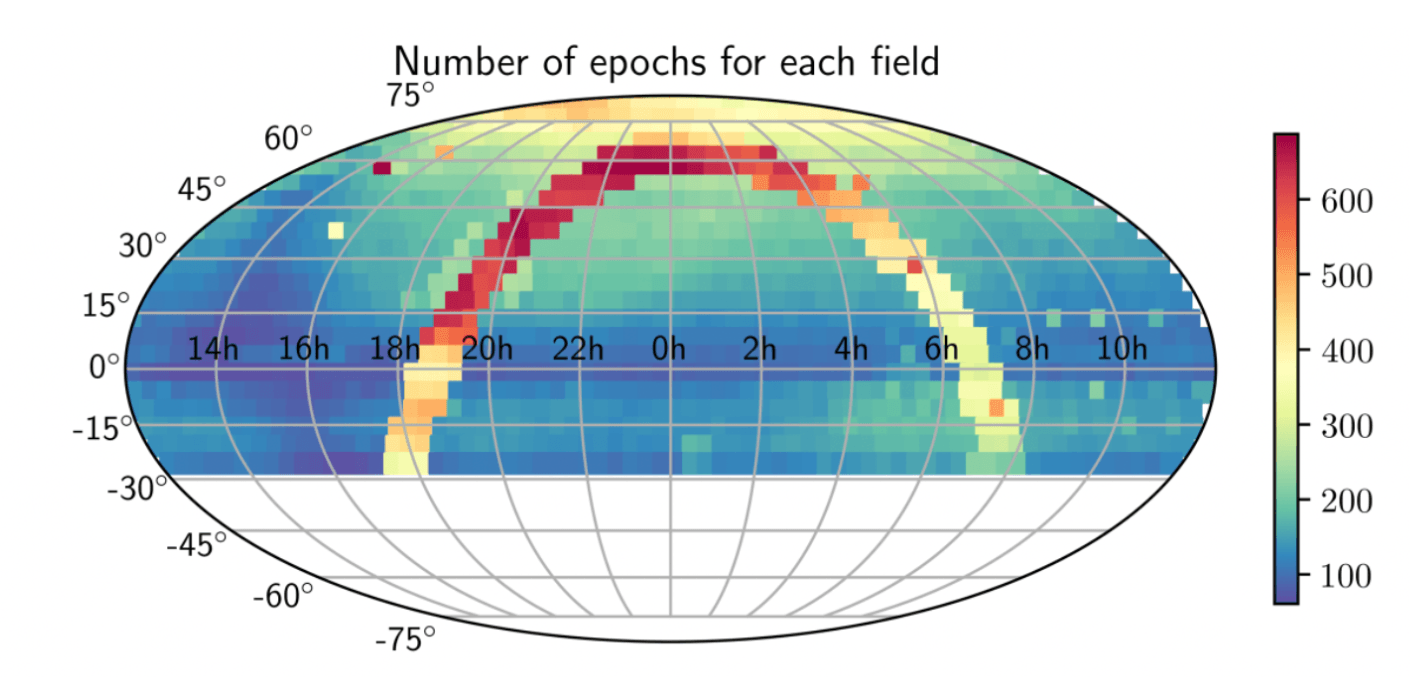PGIR (Palomar Gattini-IR)
Description
Palomar Gattini-IR (PGIR) is a wide-field, robotic, near-infrared time domain survey covering the entire visible night sky north of declination -28.5 deg at a median cadence of 2 nights. The survey operates in a single filter (J-band, calibrated to the 2MASS system), with a single exposure field of view of 25 square degrees and a native pixel scale of 8.7 arcsec/pixel. Further details about the instrument and data reduction system can be found in (De et al. 2020). Light curves are extracted by performing Point Spread Function (PSF) photometry on the stacked images from each visit of a field, with the entire observing footprint divided into 1,329 fields. The first data release contains J-band light curves of approximately 286 million sources from the 2MASS catalog, with a total of approximately 50 billion photometric measurements.
| PGIR DR1 Summary | |
|---|---|
| Area covered | 30,470 deg² |
| Bands | J |
| 5 sigma Point source depth | 15.7 AB mag (outside Galactic plane) |
| Pixel scale | 8.7 arcsec/pixel (native), 4.35 arcsec/pixel (drizzled stacks) |
| Median astrometric internal precision | ~27 mas |
| Number of sources | 286 million |
| Photometric precision | ~5% for sources brighter than 12 mag |
Scientific Goals
Palomar Gattini-IR carried out one of the first synoptic infrared time domain surveys, searching for transients and variable stars in the near-infrared bands. The dataset has been previously used to study obscured Galactic novae, outbursting young stars, nearby supernovae, dusty Wolf-Rayet stars, and evolved pulsating stars.
Data Releases
PGIR DR1
The first data release contains 4 years of light curve data since the start of survey operations in October 2018. The figure below shows the number of light curve epochs for each field in the visible footprint. During this period, PGIR primarily carried out a 1-day cadence survey of the Galactic plane and a slower cadence (∼ 4-5 days) survey of the extragalactic sky.

| PGIR DR1 Tables | |
|---|---|
| Table Name | Description |
| exposures | Metadata of each exposure included in the catalog |
| photometry | Individual photometric measurements for each source in the catalog |
| sources | Metadata and statistical moments of photometry for each 2MASS source |
Data Access
 Figure: Object number density (per square degree) in Mollweide projection for PGIR DR1 in Galactic coordinates.
Figure: Object number density (per square degree) in Mollweide projection for PGIR DR1 in Galactic coordinates.
The PGIR DR1 data is accessible by a variety of means:
Data Lab Table Access Protocol (TAP) service
TAP provides a convenient access layer to the SDSS catalog database. TAP-aware clients (such as TOPCAT) can point to https://datalab.noirlab.edu/tap, select the pgir_dr1 database, and see the database tables and descriptions. You can also view the PGIR DR1 tables and descriptions in the Data Lab table browser.
Data Lab Query Client
The Query Client is available as part of the Data Lab software distribution. The Query Client provides a Python API to Data Lab database services. These services include anonymous and authenticated access through synchronous or asynchronous queries of the catalog made directly to the database. Additional Data Lab services for registered users include personal database storage and storage through the Data Lab VOSpace.
The Query Client can be called from a Jupyter Notebook on the Data Lab Notebook server. Example notebooks are provided to users upon creation of their user account (register here), and are also available to browse on GitHub at https://github.com/astro-datalab/notebooks-latest.
Jupyter Notebook Server
The Data Lab Jupyter Notebook server (authenticated service) contains an example of how to access and visualize the PGIR catalog:
Acknowledgments
Palomar Gattini-IR (PGIR) is generously funded by Caltech, Australian National University, the Mt Cuba Foundation, the Heising Simons Foundation, and the Binational Science Foundation. PGIR is a collaborative project among Caltech, Australian National University, University of New South Wales, Columbia University and the Weizmann Institute of Science.
